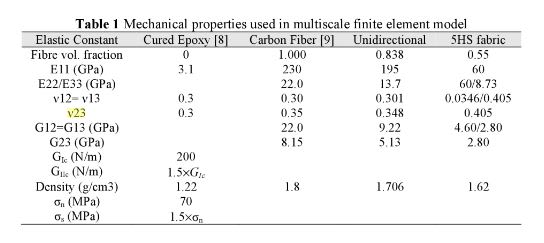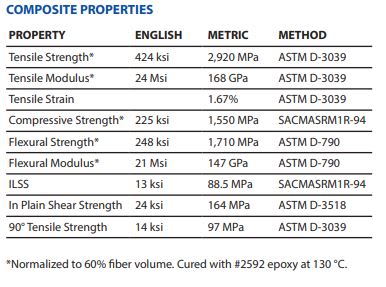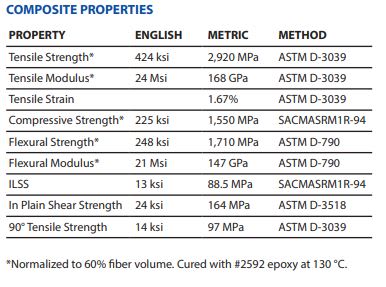Navigation
Install the app
How to install the app on iOS
Follow along with the video below to see how to install our site as a web app on your home screen.
Note: This feature may not be available in some browsers.
More options
Style variation
-
Congratulations JStephen on being selected by the Eng-Tips community for having the most helpful posts in the forums last week. Way to Go!
You are using an out of date browser. It may not display this or other websites correctly.
You should upgrade or use an alternative browser.
You should upgrade or use an alternative browser.
Shear Modulus Estimation
- Thread starter sarclee
- Start date
- Status
- Not open for further replies.
Compositepro
Chemical
That only works for a homogeneous material. Composite properties are different in each direction. My answer is based on simple logic, not specific knowledge of the equations.
SWComposites
Aerospace
No, that formula is only valid for isotopic materials.
In-plane shear modulus for most carbon/epoxy materials is ~ 0.6 Msi at RTA. See CMH-17 Volume 2.
In-plane shear modulus for most carbon/epoxy materials is ~ 0.6 Msi at RTA. See CMH-17 Volume 2.
- Thread starter
- #4
Compositepro
Chemical
Isotropic means same in x, y, and z directions.
- Thread starter
- #7
SWComposites
Aerospace
Fabric is not isotropic in the x-y in-plane directions also
- Thread starter
- #9
In some of my limited experience, I often see E1 = E2 (at least close to) for fabric prepreg.
For the properties in thickness direction, we assume transverse isotropic but the table below shows that E3 /= E2 ... Should I assume E3 = E2 based on the assumption of transverse isotropic?

Courtesy: Design, Manufacturing and Applications of Composites: Proceedings of the Ninth Joint Canada-Japan Workshop on Composites; Kyoto Institute of Technology, Kyoto, Japan July 2012
For the properties in thickness direction, we assume transverse isotropic but the table below shows that E3 /= E2 ... Should I assume E3 = E2 based on the assumption of transverse isotropic?

Courtesy: Design, Manufacturing and Applications of Composites: Proceedings of the Ninth Joint Canada-Japan Workshop on Composites; Kyoto Institute of Technology, Kyoto, Japan July 2012
SWComposites
Aerospace
For UD tape, E3 =~ E2
For fabric, E3 is not = E2 (much lower; use E2 for tape with same resin)
For fabric, E3 is not = E2 (much lower; use E2 for tape with same resin)
- Thread starter
- #11
@SWComposites, is it transverse isotropic not applied to fabric?
From '10.2.4.1 3-D lamina property determination' in MIL-HDBK-17-3F, I do notice the material properties given are unidirectional for illustrating the transverse isotropy.
I only have 2D data for running FEA. Is there any assumption we can make if no experimental data available?
From '10.2.4.1 3-D lamina property determination' in MIL-HDBK-17-3F, I do notice the material properties given are unidirectional for illustrating the transverse isotropy.
I only have 2D data for running FEA. Is there any assumption we can make if no experimental data available?
SWComposites
Aerospace
Why do you need 3D properties? Why not just model with shell elements with 2D properties?
Post the specific material you are using and the property values you have.
Post the specific material you are using and the property values you have.
- Thread starter
- #13
SWComposites
Aerospace
What is the specific Toray material? Fiber and resin? Tape or fabric? The above values are for a tape.
- Thread starter
- #15
We are looking at T800H but still checking with vendor if the panel is fabric or tape.
Datasheet:
Related thread:
*I should have created one thread for all the questions... hmmm
Datasheet:
Related thread:
*I should have created one thread for all the questions... hmmm
SWComposites
Aerospace
See page 3 here for tape and fabric properties
Kind of hard to do an analysis if you don’t know what the material is.
Kind of hard to do an analysis if you don’t know what the material is.
- Thread starter
- #17
tstanley320
Mechanical
If it is a fabric, why don't you model a unit cell of the fabric using the properties of the individual fibers and matrix using micromechanics? That way you can load the unit cell to find the tensile properties, the poisson's ratio and the shear in the plane of the fabric. It has worked well for me.
- Status
- Not open for further replies.
Similar threads
- Replies
- 2
- Views
- 2K
- Locked
- Question
- Replies
- 6
- Views
- 691
- Replies
- 4
- Views
- 1K
- Replies
- 0
- Views
- 342
- Locked
- Question
- Replies
- 7
- Views
- 859


